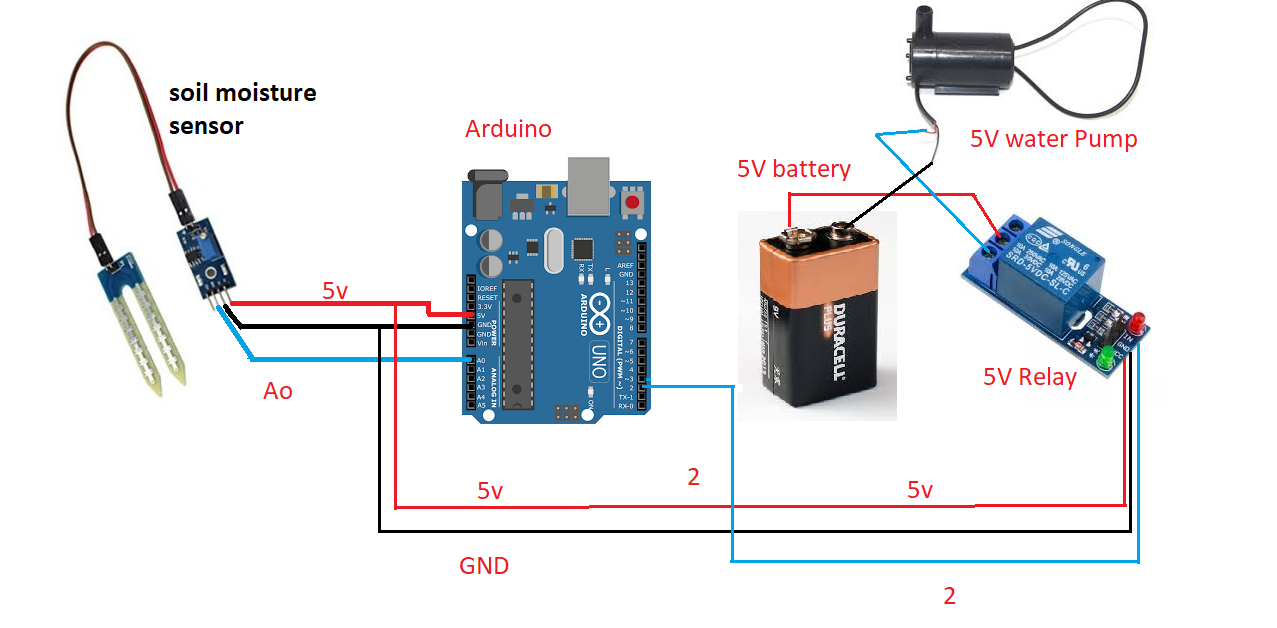Smart Irrigation System is a cost-effective water pumping system for irrigation. In this project, we have used a Soil moisture sensor to detect soil moisture levels. This data from the sensor is sent to the Arduino Uno. Based on the collected information, the Arduino decides either to start or to stop the pump motor.
Working of Smart Irrigation System:
Here we have made a smart watering system using Arduino as the main controller with other sensors.
Components used :
If you are looking to made this project I personally suggest you to buy from here.
- Arduino UNO
- Soil Moisture sensor
- Connecting wires
- 5V DC water pump
- 5V Battery
- 5V relay module
The smart irrigation system or automatic plant watering system is the solution to the modern era. We are using Arduino to control and sense the data from sensors. The Arduino will measure the moisture level using a soil moisture sensor. The soil moisture sensor is a resistor that works on moisture conditions. When the moisture is more than the resistance value will be low and when the moisture is less then the resistance value will be high.
If the soil moisture level is less than the desired value the Arduino will turn ON the relay module that will turn ON the DC water pump. The water pump will remain turned ON until the moisture level of the soil reaches the desired value. After that, the pump will be turned OFF by Arduino.
You may like to read Smart water Distribution System
Circuit Diagram and Connections smart irrigation system – Arduino:

How to make Electric Bicycle Controller Design using Arduino
We have followed the following connections in our project
- Connect the VCC of the soil moisture sensor to the 5V pin of the Arduino UNO.
- Connect the GND of the sensor to the GND pin of the Arduino UNO.
- Connect the analog data pin of the sensor to the A0 pin of the Arduino UNO.
- Connect the VCC pin of the relay module to the 5V pin of the Arduino UNO board
- Connect the GND pin of the relay module to the GND pin of the Arduino UNO board
- Connect the signal pin of the relay module to pin 2 of the Arduino UNO board.
- Connect the positive wire of the battery to the COM terminal of the relay module.
- Connect the positive wire of the water pump to the NO pin of the relay module.
- Connect the negative wire of the battery to the negative wire of the water pump.
Aims and Objectives
Aims and objective of Water-Irrigation System using GSM are as follow
- To develop a sensor-based irrigation system based on soil
- Cost-Effective
- Water-saving
- Human intervention
- Reliability
- Power consumption is low
- Best-possible water utilization for agriculture purposes.
- To increase the income from crops
How to Control Speed of Induction Motor using Variable Frequency Drive
Application Of irrigation system using Arduino
- A smart irrigation system can avoid wastage of water.
- Battery can be replaced with a Renewable source of energy.
- The system can ON/OFF the water pump automatically.
Coding (Smart Irrigation System)
int soil=A0;
int relay=2;
void setup()
{
pinMode(soil,INPUT);
pinMode(relay,OUTPUT);
digitalWrite(relay,HIGH);
Serial.begin(9600);
}
void loop()
{
int moistureLevel=analogRead(soil);
Serial.println(moistureLevel);
if(moistureLevel>980) //we can select the moisture level by selecting the different values and take which is suitable
{
digitalWrite(relay,LOW);
}
else
{
digitalWrite(relay,HIGH);
}
}
After reading this article “Smart irrigation system using Arduino” you will be able to water your plants automatically. We have tried to cover each aspect of agricultural irrigation systems and will look for more and try to add those in the next update. How does this Arduino-based irrigation system project work for you? Let us know in the comments section below.


i was inspired with your deforestation detection,unfortunate,i cant find any data about it.but thank you so much for the great work you are doing sir.